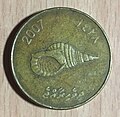Top Qs
Timeline
Chat
Perspective
Coins of the Maldivian rufiyaa
From Wikipedia, the free encyclopedia
Remove ads
The coins of the Maldivian rufiyaa are documented since it became a British protectorate in 1304 AH (1887).
The Maldive Islands were granted independence outside the Commonwealth of Nations as an independent monarchy. The 2nd Republic was declared in November 1968. The Maldive Islands returned to the Commonwealth in 1982. The Maldives was again temporarily outside the Commonwealth from October 2016 until 1 February 2020, when they returned to the Commonwealth.


Note about the Islamic calendar: The dates do not always correspond exactly, as the AH year is 11 days shorter than a year on the Gregorian calendar.
Remove ads
Coins issued from 1900–1902

In 1318 AH (1900), a copper larin (or laari) was struck. In 1319 AH (1901), a copper laari was also struck. In 1320 AH (1902), a copper laari and a 4 laari was struck.
Coins issued from 1913
These coins were an issue of 1 laari and 4 laari coins that were struck in 1331 AH (1913) at Heaton's Mint in Birmingham, England, despite the fact that they are inscribed 'Struck at Malé' in Arabic.
Coins issued from 1960
Summarize
Perspective
These coins were the last coins to have been issued under the British protectorate. They were also the only coins to have been struck during the reign of Sultan Mohammed Farid Didi (1954–1968). These coins were struck at the Royal Mint in London. They have the same dimensions as the coins of Ceylon, which were in everyday circulation in the Maldive Islands. The coins that were struck in 1960 were the following denominations:
- 1 laari
- 2 laari
- 5 laari
- 10 laari
- 25 laari
- 50 laari
There were two types of 25 and 50 laari coins. The first type has a security groove on the edge of the coin, and the other has a reeded edge. The coins are entirely inscribed in Arabic and Divehi.
The first coins to be issued by the Maldive Islands in the period outside the Commonwealth (1965–1982) was the issue of 1389 AH (1970). In this period, the first coins denominated in rufiyaa were struck. Only in the late 1970s do the dates on Maldivian coins begin to correspond exactly (e.g. the 1399 AH (1979) and 1400 AH (1980) silver 100 rufiyaa commemorative coins). Only in the late 1970s did English first appear on Maldivian coins.
Current issue
Summarize
Perspective
The first coin to be issued after the return of the Maldive Islands' return to the Commonwealth was the 1 rufiyaa coin dated 1402 AH (1982). This coin has the coat of arms on the obverse with the dates. The reverse of the coin is inscribed 'REPUBLIC OF MALDIVES 1 RUFIYAA'. A series of minor coins denominated from 1 laari to 50 laari was released into circulation in 1404 AH (1984). Since then, a number of commemorative coins have been struck, including a series of 250 rufiyaa medal-coins (listed in the 2005 edition of Krause Unusual World Coins catalogue). In 1995, the 2 rufiyaa coin was released into circulation to replace the 2 rufiyaa banknote.
A bimetallic 2 rufiyaa coin was released into circulation in 2017, replacing the previous version of the coin issued in 1995.
Remove ads
Gallery
- 2 Rufiyaa obverse
- 2 Rufiyaa reverse
- 1 Rufiyaa obverse
- 1 Rufiyaa reverse
See also
References
Wikiwand - on
Seamless Wikipedia browsing. On steroids.
Remove ads




